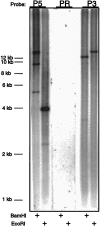A mutation in human CMP-sialic acid hydroxylase occurred after the Homo-Pan divergence
- PMID: 9751737
- PMCID: PMC21712
- DOI: 10.1073/pnas.95.20.11751
A mutation in human CMP-sialic acid hydroxylase occurred after the Homo-Pan divergence
Abstract
Sialic acids are important cell-surface molecules of animals in the deuterostome lineage. Although humans do not express easily detectable amounts of N-glycolylneuraminic acid (Neu5Gc, a hydroxylated form of the common sialic acid N-acetylneuraminic acid, Neu5Ac), it is a major component in great ape tissues, except in the brain. This difference correlates with lack of the hydroxylase activity that converts CMP-Neu5Ac to CMP-Neu5Gc. Here we report cloning of human and chimpanzee hydroxylase cDNAs. Although this chimpanzee cDNA is similar to the murine homologue, the human cDNA contains a 92-bp deletion resulting in a frameshift mutation. The isolated human gene also shows evidence for this deletion. Genomic PCR analysis indicates that this deletion does not occur in any of the African great apes. The gene is localized to 6p22-p23 in both humans and great apes, which does not correspond to known chromosomal rearrangements that occurred during hominoid evolution. Thus, the lineage leading to modern humans suffered a mutation sometime after the common ancestor with the chimpanzee and bonobo, potentially affecting recognition by a variety of endogenous and exogenous sialic acid-binding lectins. Also, the expression of Neu5Gc previously reported in human fetuses and tumors as well as the traces detected in some normal adult humans must be mediated by an alternate pathway.
Figures




References
-
- Darwin C. The Descent of Man, and Selection in Relation to Sex. New York: D. Appleton and Co.; 1871.
-
- Sarich V M, Wilson A C. Science. 1967;158:1200–1203. - PubMed
-
- Doolittle R F, Wooding G L, Lin Y, Riley M. J Mol Evol. 1971;1:74–83. - PubMed
-
- King M C, Wilson A C. Science. 1975;188:107–116. - PubMed
-
- Goodman M, Braunitzer G, Stangl A, Schrank B. Nature (London) 1983;303:546–548. - PubMed
Publication types
MeSH terms
Substances
Associated data
- Actions
- Actions
Grants and funding
LinkOut - more resources
Full Text Sources
Other Literature Sources
Molecular Biology Databases
Research Materials
Miscellaneous

